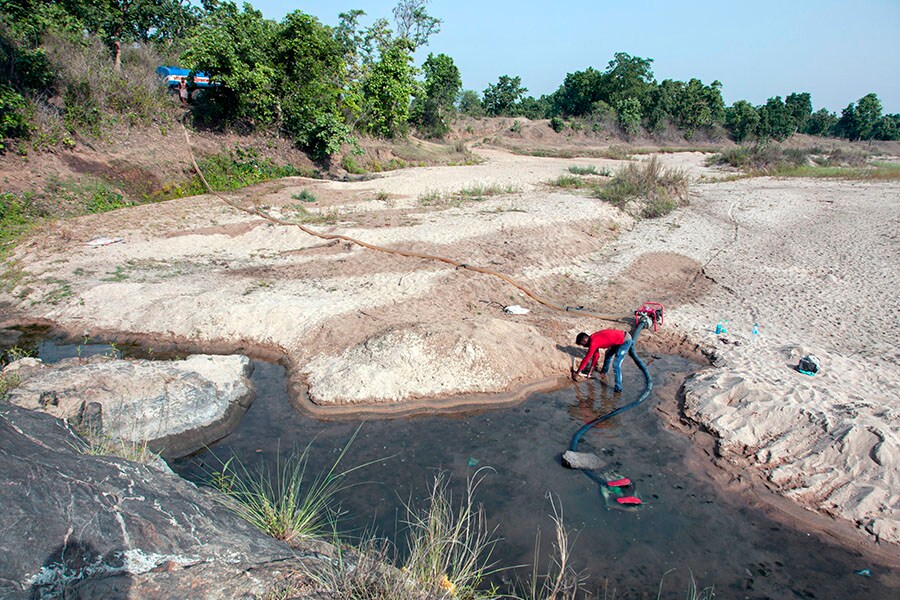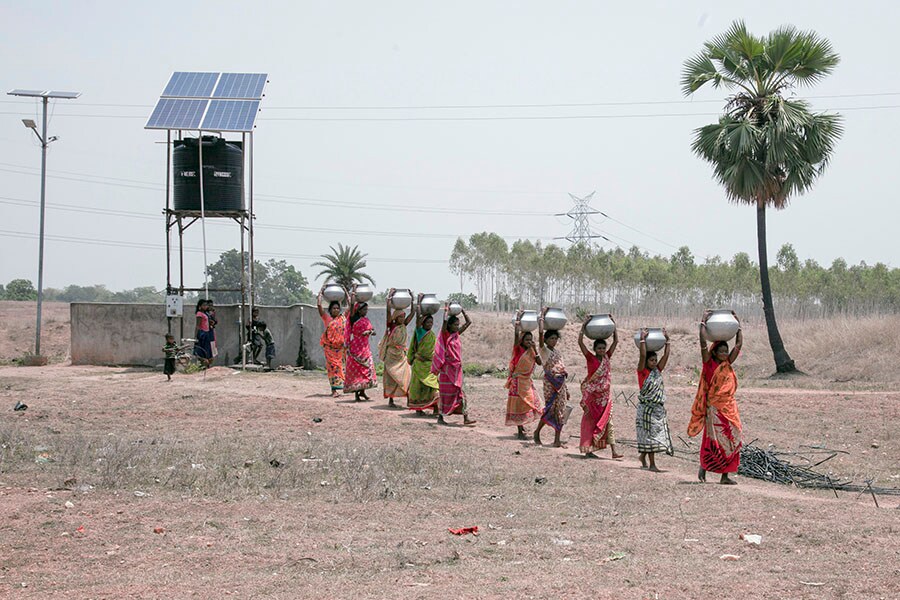
Desperate Thirst: Climate change and recurrent water crisis plaguing West Bengal's Purulia district in India
In the heart of West Bengal's Purulia district in India, recurrent droughts, soaring temperatures, and erratic rainfall cripple agriculture and livelihoods. With each year, the situation worsens, pushing communities to despair in a relentless battle against nature's whims
 In most Purulia regions, women resort to digging small bore wells in dried-up ponds or natural reservoirs for drinking water. After allowing the water to settle, they strain the top layer before filling their buckets—a laborious process borne out of necessity amidst water scarcity. All images by Subrata Biswas
In most Purulia regions, women resort to digging small bore wells in dried-up ponds or natural reservoirs for drinking water. After allowing the water to settle, they strain the top layer before filling their buckets—a laborious process borne out of necessity amidst water scarcity. All images by Subrata Biswas
Purulia district, located in the westernmost part of West Bengal, India, experiences recurrent and prolonged droughts. For the last two decades, the scenario has worsened by rising temperatures and erratic precipitation, driven by drastic changes in climate events. Due to this vulnerability, the region ranks highest in susceptibility to drought in the state, severely impacting agriculture, health, and livelihoods. Agricultural production has plunged by 65 percent, leading to malnutrition, land degradation, economic loss, and widespread mass migration. Groundwater depletion and low agricultural yields aggravate the situation. The acute water scarcity hampers the region's human development approach, exacerbating poverty and backwardness. The United Nations report (UN-WATER, 2006) emphasises the link between water development and poverty reduction, particularly in rural economies. The rising heat waves, a consequence of climate change, further compound these challenges. As per a recent Cambridge University study, Bengal ranks second in India's heat index vulnerability, indicating "extreme danger" due to heat waves intensified by climate change and posing a significant threat to its sustainable development goals.
Despite its 16 percent global population share, India possesses only 4 percent of the world's freshwater resources. India contributes to 25 percent of global groundwater extraction, making it the largest groundwater extractor since the 1980s. Six hundred million people in India combat severe water scarcity, and two lakh die yearly due to inadequate access to safe water (NITI Aayog). The frequent shifts in weather patterns, erratic precipitation, and recurrent droughts worsen the situation. The lack of safe, piped water compels approximately 75 percent of rural households to rely on unsafe sources. With over 163 million lacking access to clean water, the world's highest, India ranks seventh most vulnerable in the Global Climate Risk Index 2021 released by 'Germanwatch'. As consistent with the Climate Vulnerability Index by 'CEEW', India sees 80 percent of its populace under a steady chance of weather failures. According to a study by ActionAid and Climate Action Network South Asia (CANSA), 14 million people in India migrated due to climate change in 2020, projected to worsen with a 3.2°C temperature rise by 2050.
Purulia's tropical location and topography help funnel the monsoon currents from the Bay of Bengal to North West India. The region also holds national significance by serving as a crucial link between West Bengal's industries and the hinterlands of neighbouring states. It possesses a rich cultural heritage despite economic challenges. Purulia's rural regions contain 87.26 percent of the population, with the second-highest concentration (10.52 percent) of scheduled tribes in West Bengal, mainly residing in forested areas. Its substantial forest cover, 29.69 percent of the total land area, emphasises its socio-economic complexities and ecological importance.
Also read: India and the urgency of water crisis
Characterised by a sub-tropical climate, Purulia experiences high evaporation rates and scanty precipitation. Despite having numerous rivers in the region, nearly 50 percent of water runoff occurs due to undulating terrain. This results in meagre rainfall levels, around 1,100 mm annually, significantly lower than the state average of 1,500 mm. With temperatures soaring close to 50ºC, summers are scorching here while winters chill by temperature dropping to 3.8ºC. Agriculture, the primary livelihood, suffers from inadequate irrigation, land fragmentation, drought-induced crop failures, and acute water shortages during summers, compelling migration for better prospects. The rapid climate changes exacerbate temperature extremes and diminish rainfall, worsening agricultural challenges. Groundwater, scarce due to the rocky terrain, irrigates only 1 percent of the land, with shallow wells often drying up. Water resources like hand-dug wells, boreholes, and surface water are vital yet heavily rely upon adequate rainfall for daily use. Groundwater will become essential during summer, but insufficient recharge rates lag behind human needs, worsening the situation. Women endure the brunt by undertaking arduous journeys to fetch water from remote riverbeds twice daily. Solar taps installed by the government provide minimal relief, leaving many dependent on polluted river water for all activities. This crisis permeates the entire region, rendering wells dry and ponds desolate, compelling many to contemplate abandoning their homes. It's a perpetual nightmare from which the people of Purulia desperately seek relief.



 Purulia district, situated on the eastern slope of the Chottanagpur Plateau, features a hilly terrain with elevations ranging from 63 to 712 meters above sea level. The land surface generally lies between 150 and 300 meters. Slopes predominantly face east and southeast, defining the region's topographical layout.
Purulia district, situated on the eastern slope of the Chottanagpur Plateau, features a hilly terrain with elevations ranging from 63 to 712 meters above sea level. The land surface generally lies between 150 and 300 meters. Slopes predominantly face east and southeast, defining the region's topographical layout.











